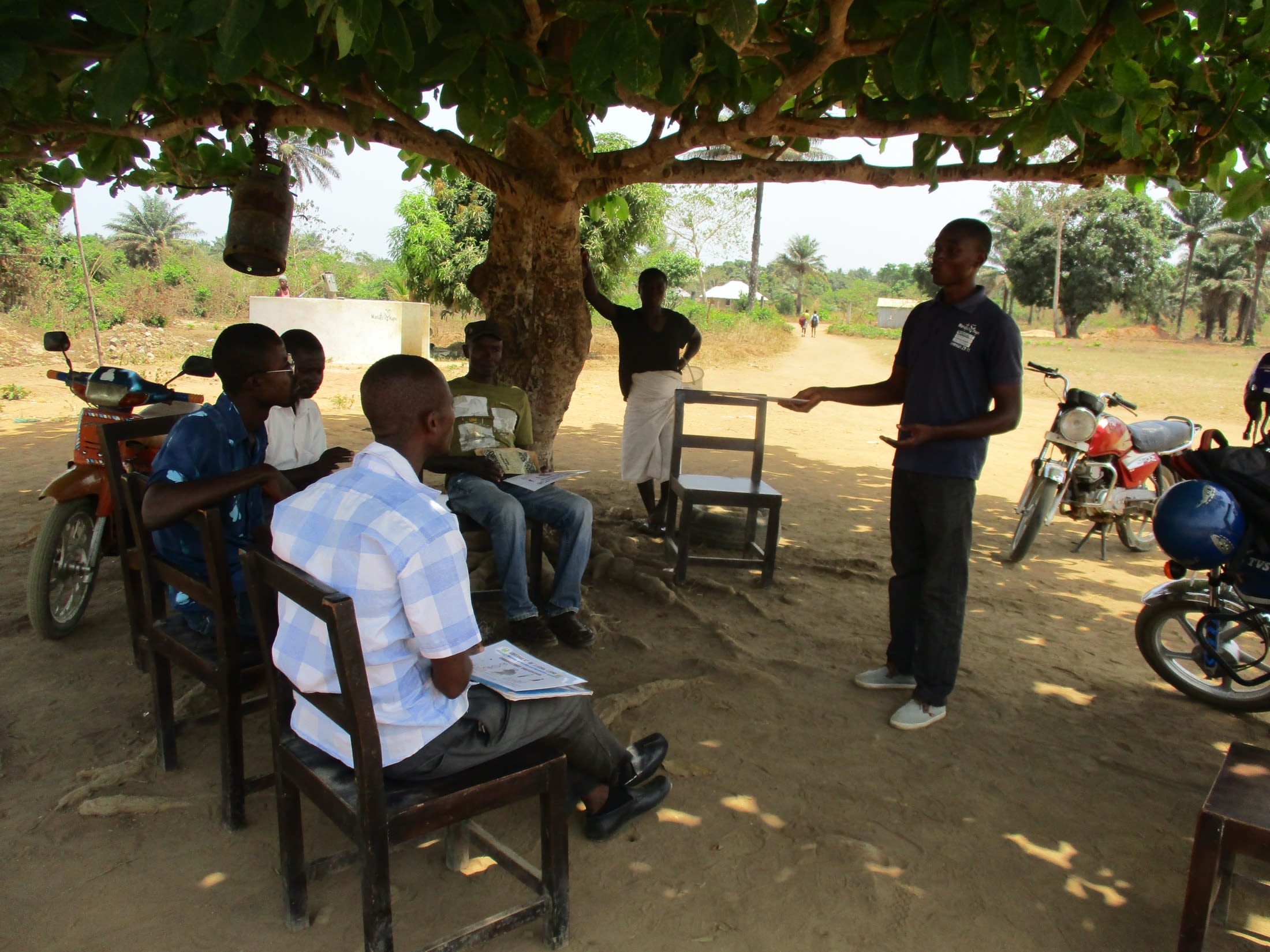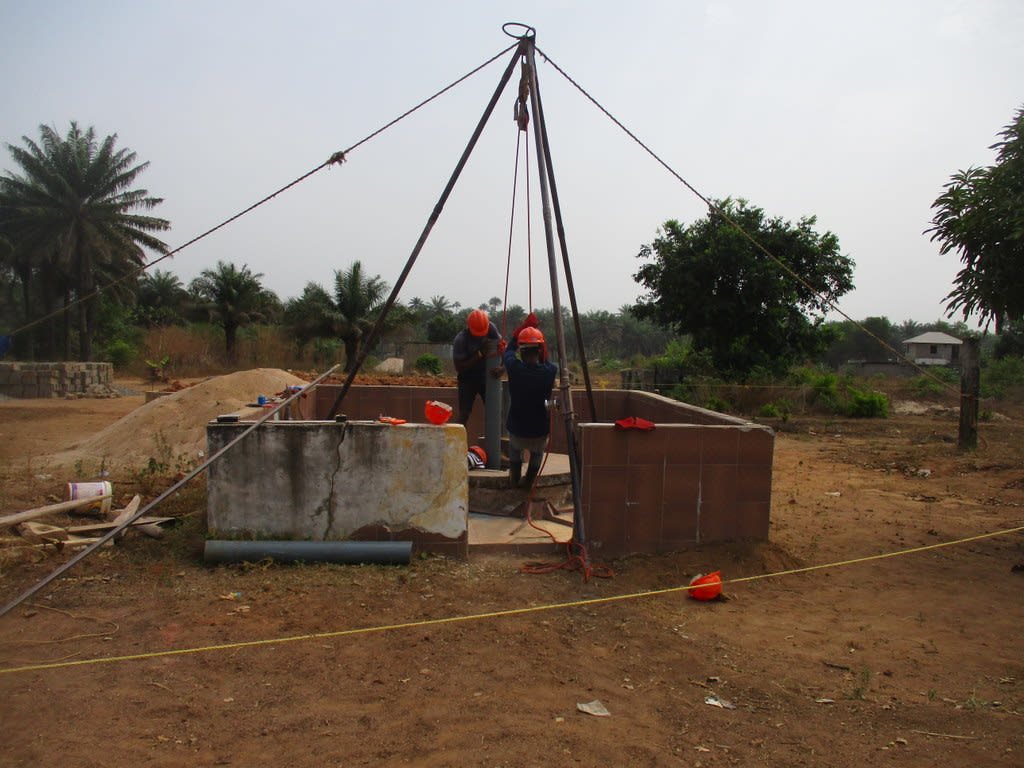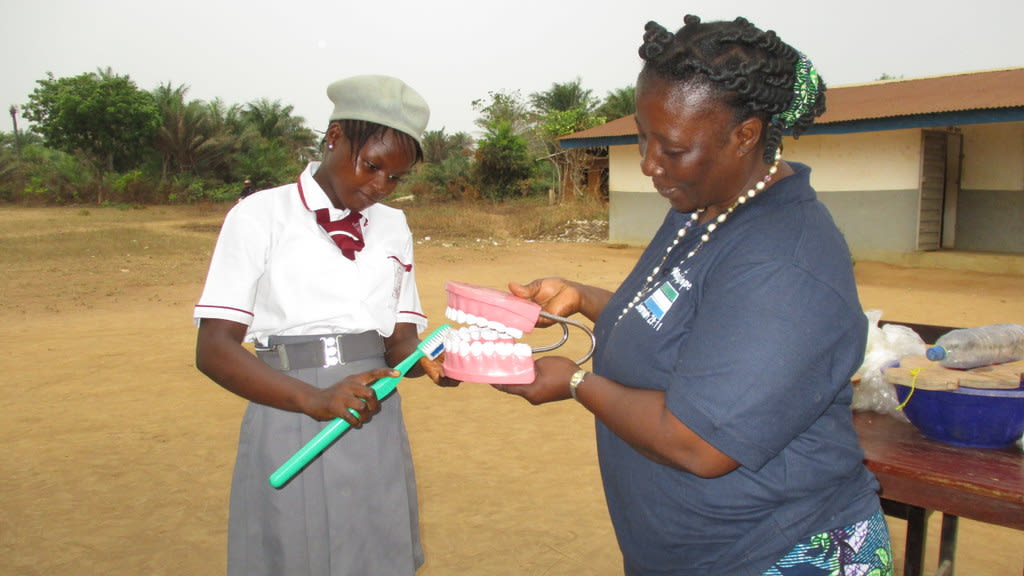May, 2020: COVID-19 Prevention Training Update at Rowana Junior Secondary School
Our teams are working on the frontlines of the COVID-19 pandemic. Join us in our fight against the virus while maintaining access to clean, reliable water.

We are carrying out awareness and prevention trainings on the virus in every community we serve. Very often, our teams are the first (and only) to bring news and information of the virus to schools like Rowana Junior Secondary School in Sierra Leone
We trained people on the symptoms, transmission routes, and prevention of COVID-19.
With distancing and/or small groups: Due to public gathering concerns, we worked with trusted community leaders to gather a select group of community members who would then relay the information learned to the rest of their family and friends.
We began training communities before the first reported case of COVID-19 in the country and before the government enacted public health guidance related to it. We worked with trusted community leaders and Water User Committees to gather community members for the training. Although community members did not observe social distancing during the training, we sensitized them on its importance and effectiveness in combating the spread of the virus.
We covered essential hygiene lessons:
- Demonstrations on how to build a simple handwashing station
- Proper handwashing technique
- The importance of using soap and clean water for handwashing
- Cleaning and disinfecting commonly touched surfaces including at the water point.

We covered COVID-19-specific guidance in line with national and international standards:
- Information on the symptoms and transmission routes of COVID-19
- What social distancing is and how to practice it
- How to cough into an elbow
- Alternative ways to greet people without handshakes, fist bumps, etc.
- How to make and properly wear a facemask.

During training, we installed a new handwashing station with soap near the community’s water point.
Due to the rampant spread of misinformation about COVID-19, we also dedicated time to a question and answer session to help debunk rumors about the disease and provide extra information where needed.
We continue to stay in touch with this community as the pandemic progresses. We want to ensure their water point remains functional and their community stays informed about the virus.
Water access, sanitation, and hygiene are at the crux of disease prevention. You can directly support our work on the frontlines of COVID-19 prevention in all of the communities we serve while maintaining their access to safe, clean, and reliable water.

May, 2019: Rowana Junior Secondary School Project Complete
We are excited to share that there is a safe, reliable water point at Rowana Junior Secondary School that’s already providing clean water to students and neighboring community members! Hygiene and sanitation training was also conducted at the school, which focused on healthy practices such as washing hands and using latrines.
Nobody was more excited about the completed project than Ibrahim S. Kamara, the Headboy for the school. He explained why:
"I was given the responsibility of choosing who fetches water from the swamp each day. It was difficult to make friends because whomever I chose for the day would be upset with me. I was always cautious of who to choose to avoid being beat up. I am thankful and grateful that the job has come to an end. I am more excited than the whole school."

Ibrahim S. Kamara
Clean Water Restored
The first thing the drill team did when they arrived at Rowana Junior Secondary School was to contact the village elders and school administrators to find a place to camp. The team was there at exactly 3 pm, by which time the principal and a few senior teachers were already there to welcome and help them find lodging. Their baggage and drill equipment was packed in a room assigned to them and they set up their tent a few meters away from the well.
Here is how we restored clean, reliable water here:
1. Raised the tripod

2. Found the original depth (for this well, we measured 66.6 feet)
3. Socketed the pipes
4. Installed casing

5. Lined up the drill rods
6. Drilled!
The team removed the hatch cover first thing in the morning and lowered a temporary six-inch PVC pipe through the open hatch to the bottom of the well. The bucket auger drill bit was connected to the drilling rod and lowered inside the temporary casing to the bottom of the well. Each drilling rod is 18 feet long. A team member pulled a rope through a pulley to raise the rod out of the casing so that two team members could empty the bucket.
This process was repeated and six inches were occasionally hammered down in order to keep the borehole straight. The first layer of tough sand was encountered after 24 feet of drilling on the first day. After the layer of sand was encountered, clay sand was met which is a sign of water.... but it is also a sign of the well potentially collapsing. Another six feet were drilled through the clay to come across another texture of clay for four feet.
The drilling was stopped at a total depth of 72 feet. The team was very confident that the reached total depth would produce the desired quantity of water, safe and clean water that will pass the water quality testing and to serve the community throughout the year without drying.
7. Installed screening and filter pack
8. Cemented an iron rod to well lining, and fixed it with an iron collar at the top
9. Bailed the well by hand for three days and flushed it

10. Tested the yield
11. Built a cement platform, walls, and drainage system
12. Installed a stainless steel India Mk11 pump

The hand-drill method allowed the team to install the cylinder far below the aquifer so that the community can have great water access throughout the year.
13. Water quality test
The school is very isolated and far from the nearest water point. During lunch hours the students used to buy water in plastic pouches. Now, water that is of better quality is at their doorstep.

The handing over ceremony was held in the morning. The school staff and students showed up in large numbers to celebrate the completed well. The students and community members erupted in songs both in the local dialect and songs of worship. The principal was very happy and almost at the point of tears because having clean water in any school creates a good learning environment for the children.
The guest of honor was the representative from the Ministry of Education Inspectorate Office, Mr. Marrah, who was at a loss for words. He praised the good work done by our teams, saying the number of people dying from waterborne illnesses has greatly decreased because of their work in all the hard to reach areas of the chiefdom. A round of applause was given for the good work and the effort to save lives in the chiefdom.

New Knowledge
The water user committee was notified of our pending hygiene training a week ahead. All nine members were contacted and asked to be present with one gallon containers. It was the responsibility of the committee to inform all the community members that are within the school compound and are going to have access to this water point.

Students at the training
The attendance was more than expected because the local headman, community members, and best of all the Ministry of Education Inspectorate office representative was present. The Ministry of Education Deputy Director had requested for the help at this particular school. Their presence was highly appreciated; it motivated all teachers, staff and students and it created a scene of full participation.
In total, more than 500 people were in attendance for the training. The training started at 11am, with the morning sun reaching just about its peak. The only refuge from the hot dry season sun is to sit under a large tree and enjoy a cup of water. A big thanks to the former principal who planted this large tree that now provides shade to this group of people!
The hygiene team was very impressed by the honesty of some of the participants who admitted that this is the first time such a training had been conducted at the school. This type of training is needed in every school to help reduce the rate of disease transmission among students. The issues and topics discussed were of great interest for the teachers and students alike.

Training topics covered included:
- The first day was the importance of handwashing and the construction of tippy taps. Easy and affordable.
- Good and Bad hygiene
- Healthy and unhealthy communities
- Disease transmission stories
- Diarrhea
- Dish racks
- Keeping the water clean
- Proper care of the pump
- Importance of having and using a latrine

The only challenge was getting people to take turns speaking. Everybody wanted to say something about the training and wanted to have their picture taken.
Good and bad hygiene was another topic of interest. A secondary school student is required to use the color white for their shirt and without proper hygiene, the uniform will resemble a piece of rag by the middle of the school year. It is not unheard of for a student to skip showering in the morning before going to school, especially if it is during the rainy season.

Bathing twice a day, cleaning toes and fingers and brushing of teeth with a toothbrush and paste are all activities that are vital to the proper growth and healthy lifestyle of an individual. The parents should be thinking about cleaning their surroundings and make sure all feces or urine left overnight in the rooms (because they don't want to go out to the latrine in the middle of the night) should be emptied into the latrines and the area scrubbed with soap and clean water.
"The handwashing topic is going to greatly have a positive effect on our lives. The training and the project have improved the lives of my students and myself," said Vice Principal Mohamed Bangura.
Thank You for making all of this possible!


 Borehole Well and Hand Pump
Borehole Well and Hand Pump




































